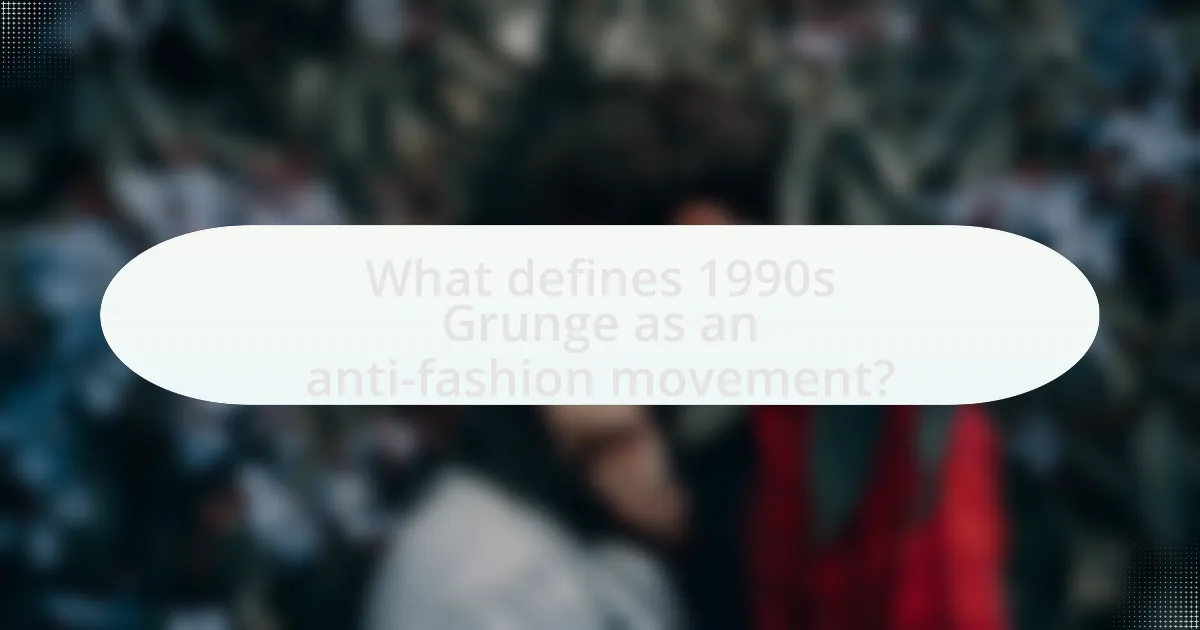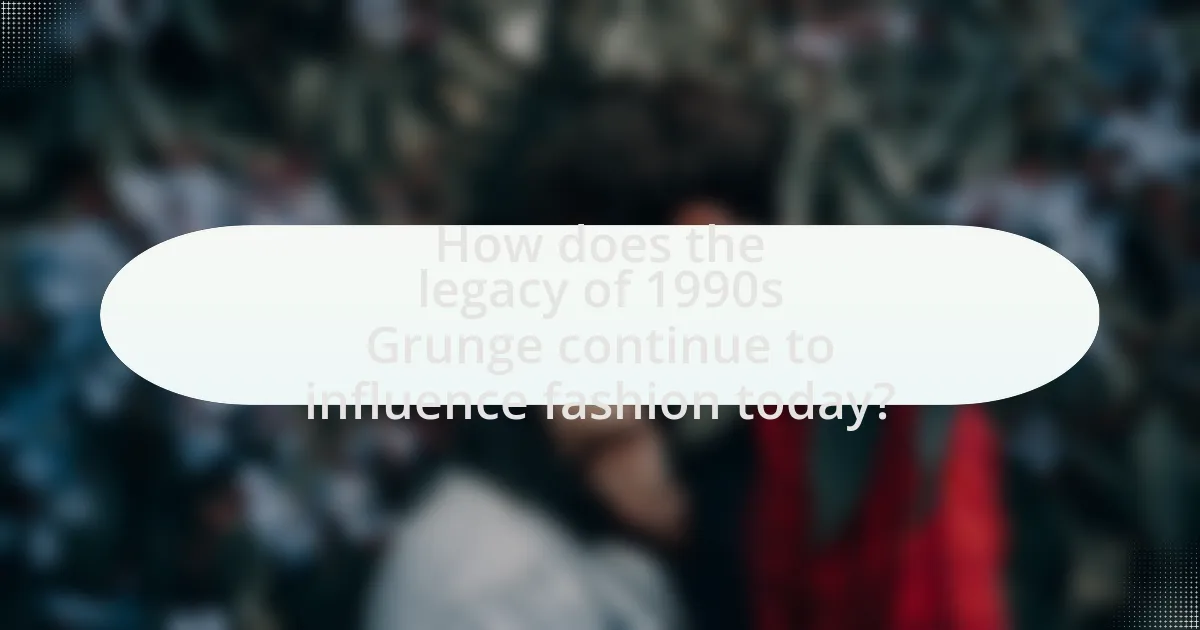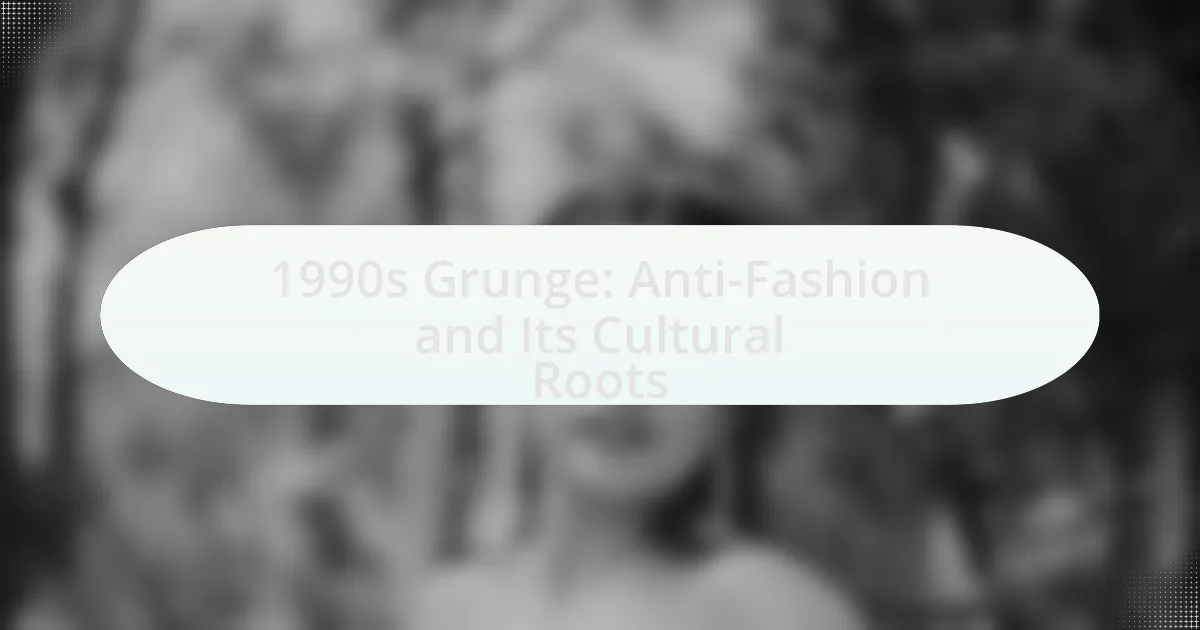1990s Grunge emerged as an anti-fashion movement characterized by its rejection of mainstream fashion norms and emphasis on authenticity. Rooted in the Seattle music scene, it was defined by a casual, unkempt aesthetic featuring thrift-store clothing, flannel shirts, ripped jeans, and combat boots, reflecting broader cultural disillusionment and economic challenges of the era. Influential figures like Kurt Cobain and Eddie Vedder popularized this style, which not only reshaped music and fashion but also fostered a sense of community among youth. The article explores the cultural, social, and economic factors that contributed to the rise of Grunge, its key characteristics, and its lasting impact on contemporary fashion and music.

What defines 1990s Grunge as an anti-fashion movement?
1990s Grunge is defined as an anti-fashion movement primarily through its rejection of mainstream fashion norms and emphasis on authenticity. This movement emerged in the early 1990s, characterized by a deliberate embrace of unkempt, thrift-store aesthetics, such as flannel shirts, ripped jeans, and combat boots, which stood in stark contrast to the polished styles of the 1980s. The cultural roots of grunge are deeply tied to the music scene in Seattle, with bands like Nirvana and Pearl Jam promoting a message of disillusionment and individuality, further solidifying its anti-fashion stance. The movement’s ethos was encapsulated in the idea that clothing should be functional and comfortable rather than a status symbol, reflecting a broader critique of consumerism and societal expectations during that era.
How did the cultural context of the 1990s influence the emergence of Grunge?
The cultural context of the 1990s significantly influenced the emergence of Grunge by reflecting the disillusionment and anti-establishment sentiments prevalent among youth during that era. This discontent was fueled by economic recession, the end of the Cold War, and a growing sense of alienation from mainstream culture, which led to a desire for authenticity and raw expression in music and fashion. The Seattle music scene, characterized by its DIY ethos and rejection of commercialism, became the epicenter of Grunge, with bands like Nirvana and Pearl Jam embodying these cultural sentiments. The popularity of Grunge was further amplified by the rise of alternative media, such as independent record labels and underground fanzines, which provided a platform for these artists to reach audiences seeking an alternative to the polished pop music dominating the charts.
What social and political factors contributed to the rise of Grunge culture?
The rise of Grunge culture in the 1990s was significantly influenced by social disillusionment and political unrest. The economic recession of the early 1990s, marked by high unemployment rates and a sense of hopelessness among youth, fostered a rejection of mainstream values and consumerism. This discontent was further amplified by political events such as the Gulf War and the perceived failures of the Reagan and Bush administrations, which led to a growing skepticism towards authority and traditional societal norms. The cultural landscape was also shaped by the rise of alternative music scenes in cities like Seattle, where bands like Nirvana and Pearl Jam articulated the frustrations of a generation, promoting a raw, unpolished aesthetic that resonated with young people seeking authenticity in a commodified world.
How did economic conditions shape the Grunge aesthetic?
Economic conditions in the early 1990s, particularly the recession and rising unemployment rates, significantly shaped the Grunge aesthetic by promoting a sense of disillusionment and anti-consumerism among youth. This economic backdrop led to a rejection of mainstream fashion trends, as young people sought to express their frustrations through a style characterized by thrift store clothing, flannel shirts, and a generally unkempt appearance. The economic hardships faced by many in the working and middle classes during this period fostered a cultural movement that valued authenticity over materialism, aligning with the ethos of bands like Nirvana and Pearl Jam, who often critiqued societal norms in their lyrics. The Grunge aesthetic thus emerged as a visual representation of the economic struggles and emotional turmoil experienced by a generation disenchanted with consumer culture.
What are the key characteristics of Grunge fashion?
Grunge fashion is characterized by its casual, unkempt aesthetic, often featuring oversized clothing, flannel shirts, ripped jeans, and combat boots. This style emerged in the early 1990s, influenced by the Seattle music scene and bands like Nirvana and Pearl Jam, which rejected mainstream fashion norms. Key elements include layering, a mix of vintage and thrift store finds, and a generally androgynous look, reflecting a rebellion against the polished styles of the 1980s. The use of dark, muted colors and a preference for comfort over formality further define this anti-fashion movement, making it a significant cultural statement of the era.
What clothing items are synonymous with the Grunge style?
Clothing items synonymous with the Grunge style include flannel shirts, ripped jeans, oversized sweaters, combat boots, and beanies. These items reflect the anti-fashion ethos of the 1990s Grunge movement, which emerged as a reaction against the polished aesthetics of mainstream fashion. The prevalence of flannel shirts, often associated with bands like Nirvana, exemplifies the casual, unkempt look that defined Grunge. Ripped jeans and oversized sweaters contributed to the laid-back, rebellious attitude, while combat boots became a staple footwear choice, symbolizing both comfort and defiance. Beanies completed the look, further emphasizing the nonchalant, effortless style that characterized Grunge fashion.
How did Grunge fashion challenge traditional fashion norms?
Grunge fashion challenged traditional fashion norms by rejecting the polished and glamorous aesthetics that dominated the 1980s, favoring instead a more disheveled and unkempt look. This movement embraced thrift store clothing, oversized silhouettes, and a mix of textures, which stood in stark contrast to the tailored and designer-driven styles of the previous decade. The rise of bands like Nirvana and Pearl Jam popularized this aesthetic, as they often wore flannel shirts, ripped jeans, and combat boots, emphasizing comfort and individuality over conformity. The cultural context of the early 1990s, marked by economic uncertainty and a desire for authenticity, further fueled this rebellion against mainstream fashion, making grunge a significant statement against consumerism and elitism in the fashion industry.
Who were the influential figures in the Grunge movement?
The influential figures in the Grunge movement include Kurt Cobain, Chris Cornell, and Eddie Vedder. Kurt Cobain, as the frontman of Nirvana, played a pivotal role in bringing Grunge to mainstream audiences with the album “Nevermind,” which featured the iconic single “Smells Like Teen Spirit.” Chris Cornell, the lead vocalist of Soundgarden, contributed significantly to the genre with his powerful voice and the band’s critically acclaimed album “Superunknown.” Eddie Vedder, as the lead singer of Pearl Jam, helped shape the movement with the band’s debut album “Ten,” which addressed themes of disillusionment and social issues. These artists not only defined the sound of Grunge but also influenced its cultural impact during the 1990s.
What role did musicians play in popularizing Grunge fashion?
Musicians played a pivotal role in popularizing Grunge fashion by embodying its aesthetic and values through their public personas and performances. Bands like Nirvana, Pearl Jam, and Soundgarden showcased a style characterized by thrift store clothing, flannel shirts, and combat boots, which resonated with the youth of the 1990s seeking authenticity and rebellion against mainstream fashion. The visibility of these musicians in music videos, concerts, and magazine covers directly influenced fans to adopt similar styles, effectively making Grunge fashion a cultural phenomenon. The Seattle music scene, where many of these bands originated, became synonymous with this fashion movement, further solidifying the connection between musicians and Grunge style.
How did artists and designers contribute to the Grunge aesthetic?
Artists and designers significantly shaped the Grunge aesthetic by embracing a raw, unpolished style that reflected the disillusionment of the 1990s youth culture. They utilized distressed fabrics, layered clothing, and a mix of vintage and thrifted items to create a look that was intentionally anti-fashion, rejecting mainstream trends. Notable figures, such as designer Marc Jacobs, incorporated Grunge elements into high fashion, exemplified by his 1993 Perry Ellis collection, which featured oversized flannel shirts and combat boots, directly influencing the fashion landscape. This collaboration between artists and designers not only popularized the Grunge aesthetic but also solidified its cultural significance as a form of rebellion against consumerism and conventional beauty standards.

What impact did 1990s Grunge have on mainstream culture?
1990s Grunge significantly impacted mainstream culture by reshaping music, fashion, and youth identity. The genre, characterized by its raw sound and anti-establishment ethos, popularized bands like Nirvana and Pearl Jam, which brought alternative rock to the forefront of the music scene. This shift led to a decline in the dominance of glam metal and pop, as grunge’s authenticity resonated with a disillusioned youth.
In fashion, grunge introduced a casual, unkempt aesthetic that included flannel shirts, ripped jeans, and combat boots, challenging the polished styles of the 1980s. This anti-fashion movement influenced major retailers, leading to the commercialization of grunge-inspired clothing in the 1990s.
Culturally, grunge fostered a sense of community among youth, promoting values of individuality and authenticity. The genre’s themes of angst and social critique reflected the struggles of a generation, making it a defining cultural moment. The lasting influence of 1990s grunge is evident in contemporary music and fashion, where its legacy continues to inspire artists and designers.
How did Grunge influence music and art during the 1990s?
Grunge significantly influenced music and art during the 1990s by introducing a raw, unpolished aesthetic that challenged mainstream norms. Musically, bands like Nirvana and Pearl Jam popularized a sound characterized by heavy guitar riffs, angst-filled lyrics, and a blend of punk and metal influences, which reshaped the rock genre and led to the rise of alternative rock. This shift is evidenced by Nirvana’s album “Nevermind,” which topped charts and brought grunge into the mainstream, selling over 30 million copies worldwide.
In the realm of art, grunge inspired a visual style that embraced a DIY ethos, often featuring distressed imagery, collage techniques, and a rejection of traditional beauty standards. Artists like David Carson in graphic design and the use of gritty, urban themes in photography reflected the grunge movement’s ethos. The Seattle art scene, closely tied to the music, showcased works that embodied the same disillusionment and authenticity found in grunge music, further solidifying its cultural impact during the decade.
What musical genres were shaped by the Grunge movement?
The Grunge movement significantly shaped alternative rock, post-grunge, and indie rock genres. Emerging in the late 1980s and early 1990s, Grunge combined elements of punk rock and heavy metal, influencing bands like Nirvana and Pearl Jam, which popularized a raw, unpolished sound. This movement led to the rise of post-grunge, characterized by a more commercial sound while retaining some of the emotional intensity of Grunge. Additionally, Grunge’s ethos and aesthetic impacted indie rock, encouraging a DIY approach and a focus on authenticity in music.
How did Grunge aesthetics manifest in visual arts and media?
Grunge aesthetics manifested in visual arts and media through a raw, unrefined style characterized by a mix of dark, muted colors, distressed textures, and a sense of anti-commercialism. This aesthetic was prominently featured in album covers, music videos, and fashion photography, reflecting the disillusionment of the 1990s youth culture. For example, the album cover of Nirvana’s “Nevermind” utilized stark imagery and a gritty feel that resonated with the grunge ethos. Additionally, filmmakers like David Fincher incorporated grunge elements in movies such as “Fight Club,” which showcased a bleak, urban environment and themes of rebellion. The visual representation of grunge often included collage techniques and a DIY approach, emphasizing authenticity and a rejection of mainstream polish.
What was the public’s reaction to Grunge as a cultural phenomenon?
The public’s reaction to Grunge as a cultural phenomenon was largely one of fascination and acceptance, particularly among youth. Grunge emerged in the early 1990s, characterized by its distinct sound and anti-fashion aesthetic, which resonated with a generation disillusioned by mainstream culture. The genre’s popularity was evidenced by the success of bands like Nirvana and Pearl Jam, whose albums topped charts and garnered critical acclaim. Additionally, the 1992 release of Nirvana’s “Nevermind” significantly shifted the music landscape, leading to a broader cultural embrace of Grunge. This acceptance was reflected in fashion trends, with flannel shirts, ripped jeans, and combat boots becoming staples among young people, symbolizing a rejection of the polished styles of the 1980s. The cultural impact of Grunge was further validated by its representation in media and fashion, with major brands incorporating Grunge elements into their collections, thus solidifying its status as a significant cultural movement of the 1990s.
How did Grunge fashion become commercialized in the late 1990s?
Grunge fashion became commercialized in the late 1990s primarily through the influence of major retail brands and the mainstream media’s adoption of the style. As bands like Nirvana and Pearl Jam gained immense popularity, their aesthetic, characterized by flannel shirts, ripped jeans, and combat boots, was embraced by fashion designers and retailers. Notably, brands such as Marc Jacobs and Calvin Klein incorporated grunge elements into their collections, showcasing them on runways and in advertisements. This shift was further propelled by celebrities and models who adopted the look, making it a trend that appealed to a broader audience. The commercialization was evident as department stores began to stock grunge-inspired clothing, transforming a subculture into a profitable fashion movement.
What criticisms were leveled against the Grunge movement?
The Grunge movement faced several criticisms, primarily for its perceived nihilism and lack of ambition. Critics argued that the movement’s embrace of disheveled aesthetics and themes of despair promoted a negative worldview, which some believed discouraged personal growth and societal engagement. Additionally, the commercialization of Grunge music and fashion led to accusations of hypocrisy, as the movement that initially rejected mainstream culture became commodified, undermining its anti-establishment ethos. This contradiction was highlighted by the rise of brands like Abercrombie & Fitch, which capitalized on Grunge styles, further alienating purists who valued authenticity.

How does the legacy of 1990s Grunge continue to influence fashion today?
The legacy of 1990s Grunge continues to influence fashion today through the resurgence of oversized silhouettes, distressed fabrics, and a general embrace of anti-fashion aesthetics. Contemporary designers and brands frequently incorporate elements such as flannel shirts, combat boots, and ripped jeans, which were hallmarks of the Grunge movement. This influence is evident in collections from major fashion houses and streetwear brands, reflecting a cultural shift towards comfort and individuality in style. The ongoing popularity of thrift shopping and vintage clothing also echoes the Grunge ethos of rejecting mainstream fashion norms, further solidifying its impact on modern fashion trends.
What elements of Grunge fashion are still relevant in contemporary style?
Elements of Grunge fashion that remain relevant in contemporary style include oversized clothing, flannel shirts, combat boots, and a general emphasis on a relaxed, unkempt aesthetic. Oversized silhouettes, which originated in the 1990s Grunge movement, continue to dominate streetwear, reflecting comfort and individuality. Flannel shirts, a staple of Grunge, are frequently incorporated into modern outfits, often layered over graphic tees. Combat boots, originally worn for their durability, have become a fashion statement, symbolizing rebellion and toughness. The overall unpolished look associated with Grunge, characterized by a mix of textures and patterns, influences current trends, promoting a casual yet expressive style. This enduring impact of Grunge fashion is evident in the collections of contemporary designers and the popularity of thrift shopping, which echoes the original ethos of the Grunge movement.
How have modern designers incorporated Grunge influences into their collections?
Modern designers have incorporated Grunge influences into their collections by integrating oversized silhouettes, distressed fabrics, and a mix of vintage and contemporary styles. For instance, brands like Balenciaga and Vetements have embraced the Grunge aesthetic through the use of flannel shirts, combat boots, and layered looks that reflect the rebellious spirit of the 1990s. Additionally, the resurgence of plaid patterns and graphic tees in recent runway shows highlights the enduring impact of Grunge on current fashion trends, demonstrating a blend of nostalgia and modernity that resonates with contemporary audiences.
What are the current trends that echo the Grunge aesthetic?
Current trends that echo the Grunge aesthetic include oversized clothing, distressed denim, and a mix of vintage and thrifted pieces. These elements reflect the original Grunge style, which emphasized comfort and a rebellious attitude against mainstream fashion. The resurgence of plaid flannel shirts, combat boots, and layered outfits in contemporary streetwear further illustrates this revival. Additionally, brands like Balenciaga and Vetements have incorporated Grunge-inspired designs into their collections, showcasing the aesthetic’s influence on high fashion. This trend is supported by the popularity of social media platforms, where influencers often showcase Grunge-inspired looks, reinforcing its relevance in today’s fashion landscape.
What lessons can be learned from the Grunge movement for today’s fashion industry?
The Grunge movement teaches today’s fashion industry the importance of authenticity and individual expression. Originating in the early 1990s, Grunge rejected mainstream fashion norms, favoring a more relaxed, unkempt aesthetic characterized by flannel shirts, ripped jeans, and combat boots. This movement emphasized comfort and personal style over polished appearances, encouraging consumers to embrace their unique identities. The success of Grunge brands like Nirvana and Pearl Jam demonstrated that authenticity resonates with audiences, leading to a lasting impact on fashion trends that prioritize self-expression over conformity. This lesson is particularly relevant today as consumers increasingly seek brands that reflect their values and individuality.
How can the anti-fashion ethos of Grunge inspire sustainable fashion practices?
The anti-fashion ethos of Grunge can inspire sustainable fashion practices by promoting a rejection of consumerism and an embrace of individuality. Grunge fashion, characterized by its thrifted, worn, and often DIY aesthetic, encourages consumers to prioritize quality over quantity, leading to reduced waste. This movement aligns with sustainable practices by advocating for the use of second-hand clothing and upcycling, which minimizes the environmental impact associated with fast fashion. Historical context shows that Grunge emerged as a response to the excesses of the 1980s fashion industry, emphasizing authenticity and personal expression over trends, thus fostering a culture that values sustainability through conscious consumption.
What strategies can brands adopt to embrace the spirit of Grunge in their marketing?
Brands can embrace the spirit of Grunge in their marketing by adopting a raw, authentic aesthetic that reflects the anti-fashion ethos of the 1990s. This can be achieved through the use of distressed materials, oversized silhouettes, and a color palette dominated by muted tones, which resonate with the original Grunge movement’s rejection of mainstream fashion norms. Additionally, brands should focus on storytelling that highlights individuality and self-expression, aligning with the Grunge culture’s emphasis on authenticity and personal identity. Collaborating with artists or influencers who embody the Grunge spirit can further enhance this connection, as seen in successful campaigns by brands like Converse and Urban Outfitters, which have effectively tapped into the nostalgia and cultural significance of Grunge.

Leave a Reply